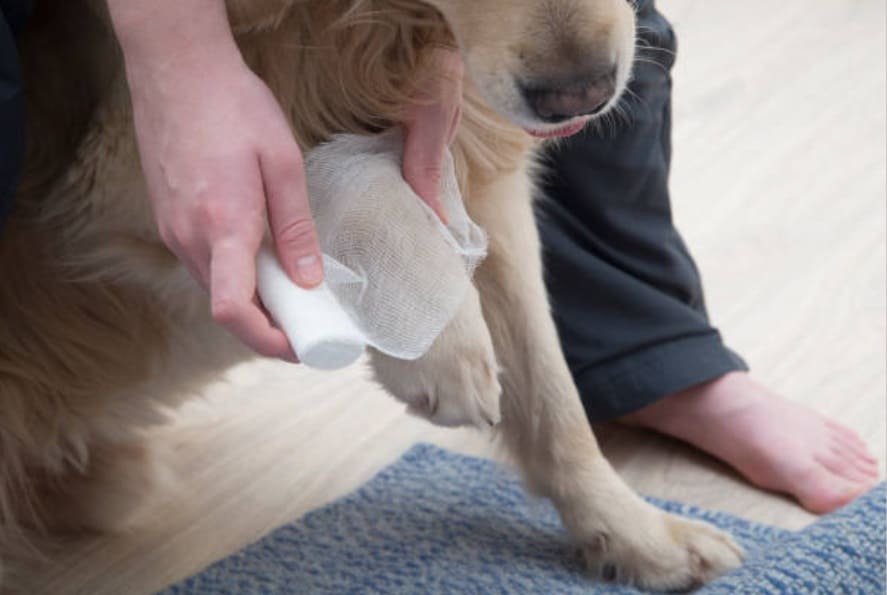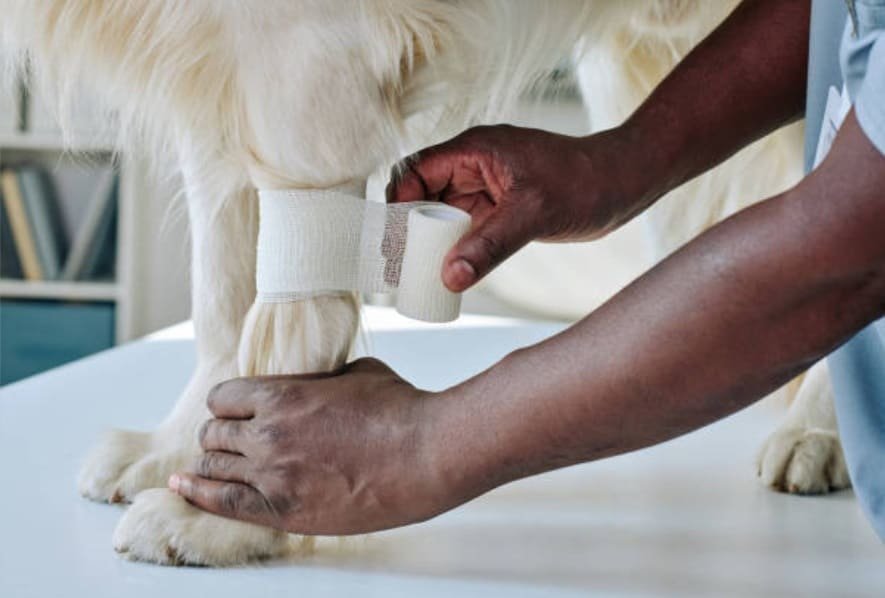How to Treat a Limping Dog at Home (12 Natural Remedies)

Limping is a common problem in dogs that can have many different causes, ranging from minor injuries to serious diseases. If you notice your dog limping, you may wonder what you can do to help them at home and when you should take them to the vet. In this blog post, we will answer these questions and provide you with some practical tips on how to treat a limping dog at home. Whether your dog is limping on the front leg or your dog is limping on the back leg, these tips will apply.
First Aid Treatment for Limping Dogs
If your dog’s limping is mild to moderate and does not require emergency veterinary care, there are some things you can do at home to help them recover faster and prevent further complications. Here are some of the basic first-aid steps for limping dogs:
Step 1. Examine your dog:
Examine your dog’s limb for any signs of injury, infection, or inflammation. Look for any wounds, bleeding, swelling, heat, redness, or pus. Also check for any foreign objects such as thorns, glass, or nails that may be stuck in your dog’s skin, nails, or pads. If you find any, carefully remove them with tweezers or scissors and clean the area with mild soap and water.
Step 2. Apply pressure to wounds:
Apply pressure to any bleeding wounds with a clean cloth or gauze until the bleeding stops. If the bleeding is severe or does not stop within 10 minutes, seek veterinary help immediately.
Step 3. Offer cold compress therapy:
Apply a cold compress to any swollen or inflamed areas for 15 to 20 minutes at a time. You can use a frozen bag of peas or corn wrapped in a towel as a cold compress. Do this several times a day for the first 24 to 48 hours after the injury. Cold can help reduce pain and swelling by constricting blood vessels and numbing nerve endings.
Step 4. Bandage injured limb:
Wrap your dog’s limb with a bandage or a splint to immobilize it and prevent further damage. You can use an elastic bandage or a vet wrap to wrap around the limb snugly but not too tightly. You can also use a cardboard box, a wooden stick, or a plastic bottle as a splint to support your dog’s limb. Make sure you leave some space between your dog’s toes and check for any signs of circulation problems such as coldness, blueness, or numbness. Change the bandage or splint every day and keep it clean and dry. Read our article about how to treat dog paw cuts to learn how to bandage an injured dog paw pad.
Step 5. Restrict your dog’s activity and keep them calm and comfortable:
Avoid running, jumping, playing, climbing stairs, or any other strenuous exercise that may worsen the condition. You may also need to confine your dog in a crate or a small room to limit their movement and prevent them from injuring themselves further. Provide your dog with a soft bed, fresh water, and a balanced diet. You can also give your dog some toys or treats to keep them entertained and distracted from the pain.
Also, learn how to treat dog stye eye to ensure sharp vision for your dog.

How to Treat a Limping Dog at Home – Natural Home Remedies
Here are some natural home remedies for a limping dog that you can try, but make sure to consult your vet before using any of them.
1. Herbs:
Some herbs have anti-inflammatory and pain-relieving properties that can help your dog’s sore joints. For example, St. John’s Wort can be applied topically to the affected area, while turmeric can be added to your dog’s food or water. However, be careful with the dosage and possible interactions with other medications your dog may be taking.
2. Massage:
Massaging your dog’s leg can help improve blood circulation and reduce stiffness. You can use warm oils like cinnamon or peppermint to make the massage more soothing. You can also try some acupressure techniques that target specific points on your dog’s body to relieve pain and promote healing.
3. Acupuncture:
Acupuncture is a form of traditional Chinese medicine that involves inserting thin needles into specific points on your dog’s body to stimulate the flow of energy and restore balance. Acupuncture can help with various conditions that cause limping, such as arthritis, hip dysplasia, or nerve damage. However, acupuncture should only be performed by a qualified veterinary acupuncturist.
4. Supplements:
Some supplements can help support your dog’s joint health and reduce inflammation. For example, omega fatty acids, glucosamine, chondroitin, and MSM are some of the most common supplements for dogs with joint problems. However, make sure to check with your vet before giving your dog any supplements, as they may have side effects or interactions with other medications your dog may be taking.
5. Epsom salt bath:
If your dog’s limping is caused by a minor injury or infection, you can try soaking his foot in warm water with Epsom salts. Epsom salts can help draw out toxins and reduce swelling and pain. After the bath, dry your dog’s foot gently and apply some antibiotic ointment to prevent infection.
6. Ice therapy:
If your dog’s limping is caused by a sprain, bruise, or tendonitis, you can apply an ice pack to the affected area for 15 minutes twice a day. Ice can help numb the pain and reduce inflammation. However, do not apply ice directly to your dog’s skin, as it may cause frostbite. Wrap the ice pack in a towel or cloth before applying it to your dog’s leg
7. Heat therapy:
Applying heat to the affected area can help to improve circulation and relieve stiffness. To use heat therapy, simply apply a heating pad or hot water bottle to the affected area for 15-20 minutes at a time. You can repeat this several times a day.
8. Arnica cream or gel:
Arnica is a flower that has been used for centuries to relieve pain and inflammation. You can apply arnica cream or gel to the affected area to help reduce pain and inflammation. To use, simply apply a small amount of arnica cream or gel to the affected area and massage it gently. You can repeat this several times a day.
9. Cabbage leaves:
Cabbage leaves are a natural remedy for bruises and swelling. To use, simply mash up some cabbage leaves and apply them to the affected area. The cabbage leaves will help to reduce swelling and pain. You can leave the cabbage leaves on for 30 minutes to an hour, or overnight.
10. Turmeric:
Turmeric is a spice that has anti-inflammatory and antioxidant properties that can help reduce pain and swelling in dogs. You can add a pinch of turmeric powder to your dog’s food or water, or make a paste by mixing turmeric with water or coconut oil and applying it to the affected area.
11. Apple Cider Vinegar:
Apple cider vinegar is a natural remedy that can help balance the pH levels and fight infections in dogs. You can add a teaspoon of apple cider vinegar to your dog’s water or food, or dilute it with water and spray it on the affected area.
12. Coconut Oil:
Coconut oil is a natural remedy that can help moisturize and heal dry, cracked, or irritated skin in dogs. You can apply coconut oil directly to your dog’s skin or pads, or add a teaspoon of coconut oil to your dog’s food.

When to Take Your Limping Dog to the Vet?
While some cases of limping in dogs can be treated at home, others may require veterinary intervention. The severity of your dog’s limping can help you to determine whether to go to a vet or to care for your limping dog at home. Take note of the severe warnings and the mild warnings.:
i. Severe limping dog warnings!! Go to the vet immediately.
Some signs that indicate your dog’s limping is severe and requires immediate veterinary attention are
- Your dog’s limping is severe and they have signs of serious injury or illness such as dangling limbs, bone protrusions, excessive bleeding, swelling, heat, pus, fever, lethargy, loss of appetite, vomiting, diarrhea, or difficulty breathing.
- Your dog’s limping does not improve or worsen after 24 to 48 hours of home treatment.
- Your dog’s limping is chronic and has been present for more than two weeks without any improvement.
- Your dog’s limping is intermittent and occurs on and off or after specific activities such as running or jumping.
- Your dog has other health problems or conditions that may affect their limbs such as diabetes, arthritis, or cancer.
ii. Mild limping dog warnings – You are free to treat at home.
Some signs that indicate your dog’s limping is mild to moderate and may be treated at home are:
- Your dog has a slight limp or favors one limb over another.
- Your dog has minor cuts, scrapes, bruises, or swelling in the affected limb.
- Your dog is still able to walk and bear some weight on the affected limb.
- Your dog has no other symptoms and is otherwise healthy and active.
Is your dog limping? Watch this video to try the safe and effective home remedies recommended.
What Will a Veterinarian Recommend For Treating a Limping Dog?
Your vet will examine your dog’s limb and perform some tests such as x-rays, blood tests, or joint fluid analysis to determine the exact cause and severity of your dog’s limping. They will then prescribe the appropriate treatment for your dog, which may include:
1. Medication:
Your vet may prescribe some medication for your dog such as antibiotics, anti-inflammatories, painkillers, steroids, or supplements to treat the underlying cause and relieve the symptoms of your dog’s limping.
2. Surgery:
Your vet may recommend surgery for your dog if they have a severe injury or disease that affects their bones, joints, muscles, tendons, ligaments, or nerves. Surgery may involve repairing, removing, or replacing the damaged tissue or structure.
3. Physical Therapy:
Your vet may suggest physical therapy for your dog if they have a chronic or degenerative condition that affects their mobility and function. Physical therapy may involve exercises, massage, hydrotherapy, acupuncture, laser therapy, or electrical stimulation to improve your dog’s strength, flexibility, range of motion, and pain relief.
4. Alternative Therapy:
Your vet may advise alternative therapy for your dog if they have a mild or moderate condition that responds well to natural remedies. Alternative therapy may include herbal medicine, homeopathy, aromatherapy, or chiropractic care to enhance your dog’s healing and well-being.

What Medicine Can You Give a Dog for Limping?
If your dog is in pain, you may want to give them some pain relief medication. However, you should never give your dog any human painkillers such as aspirin, ibuprofen, or acetaminophen (Tylenol), as they can be toxic or harmful to dogs. Instead, you should consult your vet and ask for a prescription or recommendation for a safe and effective painkiller for dogs. Some of the most common painkillers for dogs are;
A. Carprofen:
This is a non-steroidal anti-inflammatory drug (NSAID) that can reduce pain and inflammation in dogs. It is sold under various brand names such as Rimadyl, Novox, or Vetprofen. The usual dose is 2 to 4 mg per kg of body weight, given once or twice a day. The most common side effects are vomiting, diarrhea, loss of appetite, or liver damage.
B. Meloxicam:
This is another NSAID that can reduce pain and inflammation in dogs. It is sold under various brand names such as Metacam, Loxicom, or Mobic. The usual dose is 0.1 mg per kg of body weight, given once a day. The most common side effects are vomiting, diarrhea, loss of appetite, or kidney damage.
C. Tramadol:
This is an opioid analgesic that can reduce moderate to severe pain in dogs. It is sold under various brand names such as Ultram, ConZip, or Ryzolt. The usual dose is 1 to 5 mg per kg of body weight, given two to four times a day. The most common side effects are sedation, nausea, constipation, or seizures.
Always follow your vet’s instructions and monitor your dog for any adverse reactions when giving them painkillers. If you notice any signs of overdose or toxicity such as vomiting, diarrhea, lethargy, difficulty breathing, or abnormal behavior, stop the medication and contact your vet immediately.

What Causes Limping in Dogs?
If your dog is limping, it could be a sign of an injury or an underlying health condition. It is important to understand the cause of your dog’s limp to provide the appropriate treatment. There are many possible causes of limping in dogs however, some common causes of canine limping include:
1. Injuries:
This is the most common cause of limping in dogs. Dogs can get injured from running, jumping, or playing. Injuries can range from minor to severe and can include bone fractures, ligament sprains, muscle strains, joint dislocations, and wounds.
2. Inflammation:
Inflammation of the bones, joints, muscles, or tendons can also cause limping. This can be caused by a variety of factors, including infection, arthritis, or autoimmune disorders.
3. Developmental disorders:
Some dogs are born with congenital defects that can lead to limping. These defects can affect the development or function of the bones, joints, muscles, or nerves of the limbs.
4. Infections:
Bacterial or fungal infections of the bones, joints, or soft tissues can also cause limping. For example, if your dog has a paw infection, it might limp to avoid putting pressure on the affected paw.
5. Cancer:
This includes tumors or growths that can affect any part of the body, including the bones, joints, and nerves. This can lead to limping if the cancer causes pain or damage to the affected area.
6. Joint Disease:
Joint diseases like arthritis can cause limping in dogs. If your dog is older and has been limping for a while, it could be a sign of joint disease.
7. Bone Disease:
Bone diseases like osteosarcoma can cause limping. If your dog’s limp is persistent and not improving, it is important to get them evaluated by a veterinarian.
8. Nervous system disorders:
This includes spinal cord injuries, intervertebral disc disease, nerve damage, or other conditions that affect the transmission of signals from the brain to the limbs. These injuries damage the nerves that control movement and cause limping in dogs.
9. Degeneration:
This includes osteoarthritis, hip dysplasia, elbow dysplasia, patellar luxation, and other conditions that cause wear and tear of the cartilage and bones of the joints of the limbs.
In the next section, we will discuss the severity of your dog’s limping to know when to go to a vet and when to offer home remedies for limping dogs.

How can I tell which leg my dog is limping on?
To tell which leg a dog is limping on, you can observe the dog’s head and body movements. With a front leg lameness, dogs will raise their head up when the sore leg touches the ground and lower their heads when bearing weight on the good leg. With hind-leg lameness, dogs will lean forward to take the weight off their back end, and you should see their tail or affected hip rise when the sore leg touches the ground.
Another way to tell which leg a dog is limping on is to get the dog trotting towards you from a distance of 10 to 20 meters. Start by watching the head and counting the rhythm: “up, down, up, down, up, down, etc”. Now keep counting the rhythm and shift your gaze to the legs. The leg that is in use when you say “up” is the leg the dog is limping on.
Watch the video below to learn how to check which leg your dog is limping on.
How to Care for a Limping Dog at Home
Here are some actionable tips on how to care for a limping dog at home:
- Restrict your dog’s activity. Keep your dog calm and minimize their activity to allow the injury to heal. This will help to reduce pain and inflammation. Keep your dog from running, jumping, or playing. You may also want to keep your dog from stairs or other surfaces that could put stress on the affected limb.
- Provide your dog with a comfortable place to rest. A soft bed or cushion can help to keep your dog comfortable and pain-free. You may also want to place a ramp or stairs leading to your dog’s bed to make it easier for them to get up and down.
- Apply ice or heat to the affected area. Ice can help to reduce pain and inflammation, while heat can help to improve circulation and relieve stiffness. Apply ice for 20 minutes at a time, several times a day. Heat can be applied for 15-20 minutes at a time, several times a day.
- Give your dog pain medication. Your veterinarian can prescribe pain medication to help your dog feel more comfortable. Be sure to follow the veterinarian’s instructions carefully.
- Monitor your dog’s condition. Keep an eye on your dog’s limp and watch for any changes in their behavior. If the limp worsens or your dog seems to be in more pain, contact your veterinarian.
Here are some additional tips to prevent limping in dogs:
- Avoid giving your dog human pain medication. Human pain medication can be toxic to dogs, so it is important to only give your dog medication that has been prescribed by a veterinarian.
- Keep your dog’s weight down. Excess weight can put stress on your dog’s joints, so it is important to keep your dog at a healthy weight.
- Feed your dog a healthy diet. A healthy diet can help to keep your dog’s joints healthy and reduce the risk of inflammation.
- Take your dog for regular walks. Regular exercise can help to keep your dog’s joints healthy and reduce the risk of limping.
- Ensure proper grooming for your dog. Grooming can help keep your dog’s skin, nails, pads, and fur clean and healthy. It can also help prevent infections, parasites, or injuries that may affect your dog.
FAQ
Here are some of the frequently asked questions about how to treat a limping dog at home:
Q: Can I give my dog aspirin for limping?
No, you should never give your dog aspirin or any other human painkillers for limping, as they can be toxic or harmful to dogs. Aspirin can cause stomach ulcers, bleeding disorders, liver damage, kidney damage, or even death in dogs. If you want to give your dog some pain relief medication, you should consult your vet and ask for a prescription or recommendation for a safe and effective painkiller for dogs.
Can a dog live with a limp?
Yes, a dog can live with a limp. However, in moderate to severe cases, dogs may limp chronically due to pain and discomfort. If left untreated, arthritis and other orthopedic abnormalities can develop that will significantly affect the quality of life, even if life expectancy is not affected. It’s important to consult with a veterinarian to determine the underlying cause of the limp and to provide appropriate treatment.
How long does it take for a limp to go away?
The amount of time it takes for a limp to go away depends on the underlying cause. In some cases, the limp may go away on its own within a few days or weeks. In other cases, it may take longer, or surgery may be necessary.
Can I perform heat or cold therapy on my limping dog?
Yes, you can perform heat or cold therapy on your limping dog. If there’s swelling in the affected limb, apply an ice pack to the area for 15 to 20 minutes at a time.
Are there any natural remedies for treating a limping dog at home?
Yes, there are natural remedies for treating a limping dog at home. These include rest, ice, compression, massages, and warm compresses.
How can I monitor my dog’s progress if they are limping?
You can monitor your dog’s progress by observing its behavior and mobility. If their limp persists for more than a few days or gets progressively worse, it’s a good idea to call your veterinarian.
What should I do if my dog is limping?
If you notice your dog limping, remain calm and carefully examine the dog for injuries. You can provide pain relief with vet-approved medication and use home remedies like massages and warm compresses. Offer a balanced diet and gentle exercise, and confine your limping dog to limit their physical activity and avoid further damage or pain.
How can I determine the root cause of my dog limping?
It’s important to determine the root cause of your dog’s limping. You can do this by examining the affected limb for signs of injury, swelling, or bleeding. If there’s a lot of swelling or bleeding, a hot limb, or their leg isn’t supporting any weight, you should apply first aid using our tips and take them to an emergency clinic as soon as possible
Does a limping dog need a wheelchair?
A limping dog may or may not need a wheelchair. It depends on the severity of the limp and the underlying cause. If the limp is caused by a minor injury, such as a sprain or strain, the dog may only need rest and pain medication. However, if the limp is caused by a more serious condition, such as arthritis or hip dysplasia, a wheelchair may be necessary to help the dog get around.





